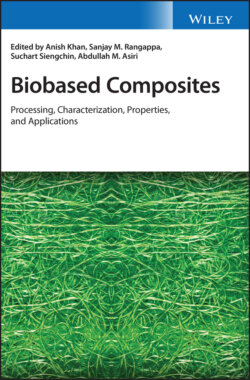Читать книгу Biobased Composites - Группа авторов - Страница 37
2.5.3 Biobased Filler/Reinforcement and Biobased Polymer
ОглавлениеBiobased composites with natural fiber reinforcements have several advantages over those with synthetic reinforcements and has become one of the most popular research topics of the decade. Further, natural polymers derived from renewable resources are ecofriendlier and less expensive compared to synthetic polymers. Hemp, keratin, pure cellulose fibers, and flax are used to produce composites with very good dampening properties and high flexibility [51, 52]. In the current research scenario, focus is on enhancing the fiber–resin interactions, neglecting fiber orientation. The poor uniformity in the fiber length and orientation in biobased composites results in huge variations in the mechanical properties of similar samples and hence represents one of the major limitations for its use as a commercial product. Researchers are carrying out both physical and chemical surface treatments for presenting them successfully in the market as a competitive alternative to synthetic fibers. Each component in the natural fiber composite has been separated and studied individually for optimizing the fiber–matrix interactions and also to completely understand their physical properties. Thermotreatment [53], calendaring [54], fiber stretching [55], and electric discharge [56] are some of the common optimization methods available. The methods indicated herein are used to improve the surface of the fibers physically on a macroscale and they do not alter or induce any chemical changes in the fibers. In some cases, they could also be used to improve the adhesion with the polymer matrix and also fiber orientation. Shorter fibers from high cellulose content fibers and plant particulates could be filtered by using Solvent extraction technique.
In some cases, in order to improve the fiber–matrix interactions, the chemical treatment of the fibers is also carried out. Alkaline treatments of fibers can be used as a pretreatment method in addition to the chemical modifications that are carried out. Alkalis like sodium hydroxide could be used for treating the fibers in which the cellulose lattice is converted into a more stable form [57]. It has been found that the mechanical properties of flax/epoxy polymers are increasing at a significant rate than the nontreated samples after alkaline treatment [58]. On the other hand, if there is no stretching of the fibers during the NaOH/water alkaline treatment, then it results in the shrinkage of the fibers [59]. Water can be substituted with ethanol for overcoming this problem [59]. Another method used for enhancing the interfacial adhesion between the reinforcements and the polymer matrix is the use of coupling agents, such as organosilanes which is a common chemical modification method [60]. Even though there occurs a decrease in the crystallinity of the reinforcements, there is still an increase in the tensile properties of the PLA/wood flour composites. Morphological analysis also proves that there is a stronger interfacial bonding that occur in the developed composites.
